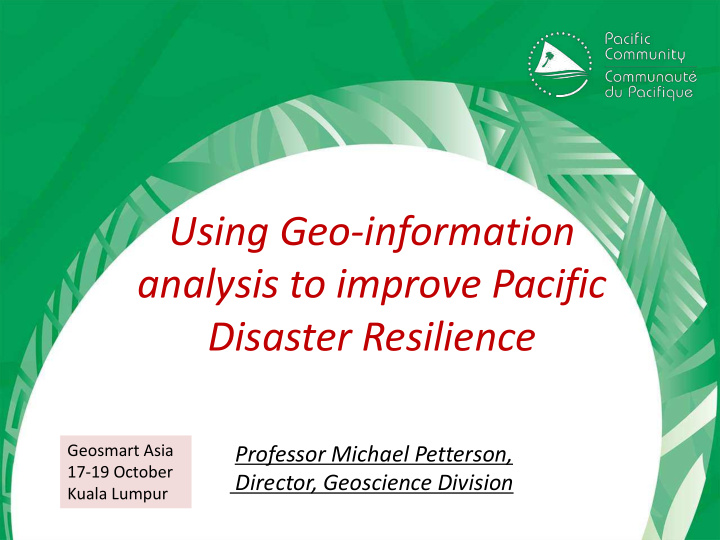



Using Geo-information analysis to improve Pacific Disaster Resilience Geosmart Asia Professor Michael Petterson, 17-19 October Director, Geoscience Division Kuala Lumpur
Pacific Environment: volcanoes, cyclones, storm surge, Floods, landslides, tsunamis, unsafe ground conditions, earthquakes…etc. Rabaul, PNG
Samoa tsunami, 29 Sep 2009, Mag 8.1: 189 killed 30% of GDP Affected
Cyclone PAM: 13 March 2015: Vanuatu: 66% of GDP Affected
Low lying Atoll Countries: King Tides Storm Surge Droughts
Best way forward: Science into risk, policy and advice…but how? BUT: understanding Science & data is difficult Complex seismograph
So we need an expert team and systems
And we pull together an informed decision support tool
Triggers & causative factors for landslides in Papua New Guinea (Joanne Robbins)
Landslide-triggering event inventory: PNG Landslide-triggering event is a meteorological, geological Landslide Types* 1 or hydrological event/hazard which led to landslides. Triggering event meta-data sources (1) Technical/Site inspection reports (PNG MRA* 2 & DMPGM* 3 ) (2) Journal publications (3) Newspaper records Joanne (4) Internet publications (ReliefWeb) Robbins * 1 Landslide type images courtesy of USGS from their website: (5) Supplementary archives (Dartmouth PhD http://pubs.usgs.gov/fs/2004/3072/images/Fig3grouping-2LG.jpg Flood Observatory, USGS Earthquake * 2 MRA = Mineral Resources Authority in PNG * 3 DMPGM = Department of Mineral Policy and Geohazards Management Catalogue)
Joanne Robbins: Landslide Probability Analysis for PNG
Tongatapu Tsunami Modelling Working with GeoScience Australia
UAV Lidar and Point Cloud http://gsd.spc.int/pointcloud
Regional: PacGeo Deployed in 2013 Cloud deployed 900~ layers 950~ related documents 40~ Users across PICs trained www.pacgeo.org Small offline functionality In countries with limited Internet access Use Geonode & GeoServer software
Regional: Pacific Risk Information Products of PCRAFI Phase 1 Derived from largest field surveys taken in the Pacific Multiple attributes collected over infrastructure, population, hazard, land use, etc. pcrafi.spc.int World Bank Project: Now moving into PREP Programme Socio-Economic & Hazard Science Data & Population & Infrastructure
Decision Support Tools: PacSafe & World Bank PREP Programme http:// services.gsd.spc.int/pacsafe
What does PacSafe do?
PacSafe: Hazard & Exposure Layers Buildings Communities People Socio-Economic Vulnerability Risk
Example: Flood/Building Nadi, Fiji
Example: Flood/Population Nadi, Fiji
Example: Flood/Building Apia, Samoa
Example: Christmas Island Shoreline Change Detection
Capacity Building in PIC 77% GIS/RS Users in Pacific Governments, Regional Agencies and Academia, use QGIS according to a recent online survey conducted by GIZ/MacBIO. 90+ Pacific Island Nationals trained on QGIS and related FOSS4G Toolsets in 2015 alone, by Geoscience Division, Pacific Community, via Regional Workshops, In-Country Training, and Internship attachment Schemes. 4+ Major Regional Players actively involved in QGIS Capacity Building in the Pacific Island Countries: • SPC (Geoscience, Fisheries and Stats Division) • CSIRO (Kiribati, Solomons) • GIZ-funded MacBIO/IUCN • USP (Bachelor of Geospatial Science, 2015 -) • www.pacgeo.org/edu services.gsd.spc.int/workshop
Resilient Investments: Conclusions • First: know you hazard and know your risk • Second: Map the hazard, map the risk • Third: Combine with socio-economic & infrastructure data • Fourth: Calculate Probabilities • For everything: work closely with your target audience all the way (planners, government, investors): design tools they know and will use to inform decisions
Recommend
More recommend